12 Mistakes Everyone Makes Cooking Spaghetti Squash

When summer ends and the weather turns cool, it's time for winter squash season. Of course, pumpkin is the most famous of the winter squashes, getting all the attention, but there are other tasty winter squashes that also deserve a place in the spotlight. One of those is spaghetti squash, an oval-shaped yellow squash that gets its name from the noodle-like strands that are hiding inside. It's widely available in most supermarkets in the fall through winter.
As the name suggests, the most common way to use spaghetti squash is as a pasta or noodle substitute. If you follow a gluten-free or low-carb diet, you may already be familiar with this carb-free pasta replacement and its neutral flavor. It pairs well with sauces from acidic tomato to creamy Alfredo to umami-rich gravy. Even if you don't follow a low-carb diet, you'll still want this lesser-known squash on your radar because it's a filling, high-fiber food rich in vitamin C and antioxidants, making it perfect for the cold and flu season.
The only downside to this winter squash is that it can be intimidating. The tough outer skin can make it a tricky vegetable for home chefs, but it doesn't have to be. If you want to enjoy this seasonal squash but aren't sure how to cook it, this article explores the mistakes people often make when cooking spaghetti squash so you can avoid them when you add it to your fall menu.
Read more: 12 Vegetables And Fruits That Used To Look Very Different
Buying Out Of Season

The best time to find spaghetti squash is August through October. Many supermarkets will have it year-round, but buying it in season is always the best choice, even though the season is relatively short. Luckily, spaghetti squash has a long shelf life, and an uncut squash can sit in a cool, dark pantry for one month. It also freezes well once it's been cooked.
The best way to freeze cooked spaghetti squash is to remove the strands and let them sit in a colander for a few hours with a sprinkle or two of salt to remove the excess moisture, then give it a good squeeze and place it in freezer-safe bags. Once you freeze a spaghetti squash, it can be stored for up to one year so that you can enjoy spaghetti squash noodles all year long. If you prefer your strands to be more on the al dente side, undercook the squash before removing them. This helps them keep their texture when you defrost them.
Not Knowing How To Choose A Spaghetti Squash
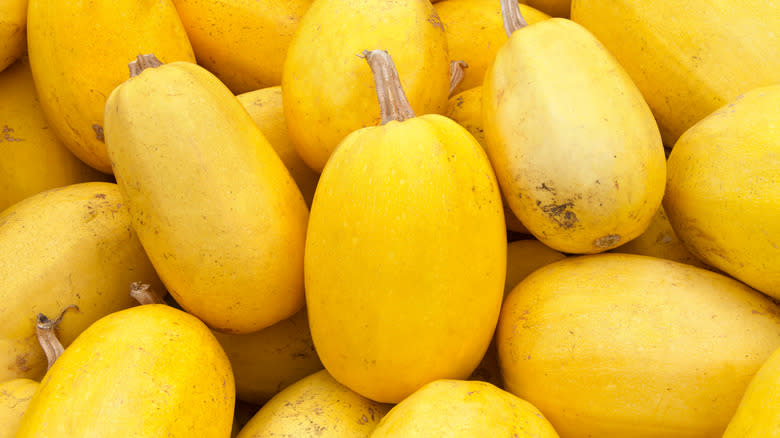
You want to start with a good spaghetti squash, but how do you tell if it's good or not? Should you squeeze it? Or smell it? Unfortunately, winter squash, like spaghetti squash, has that tough outer skin, so it's hard to use either of these tricks to check for freshness. What's more, since they vary in size, that won't help you find a good one either.
The best way to choose a spaghetti squash is simply by the color. It should be a bright yellow, but watch out for shiny skin which means it's not quite ripe yet. Make sure to look for outside skin defects like green or white spots. A discolored spaghetti squash can also be a sign that it isn't really ripe yet. On the other hand, any dark spots, bruises, or squishy spots indicate that it's past its prime, and any damaged or punctured skin is a telltale sign that you should keep looking. Another way to tell if the squash is good is to use your ears. When you give it a little tap, it should sound hollow.
Using A Dull Knife
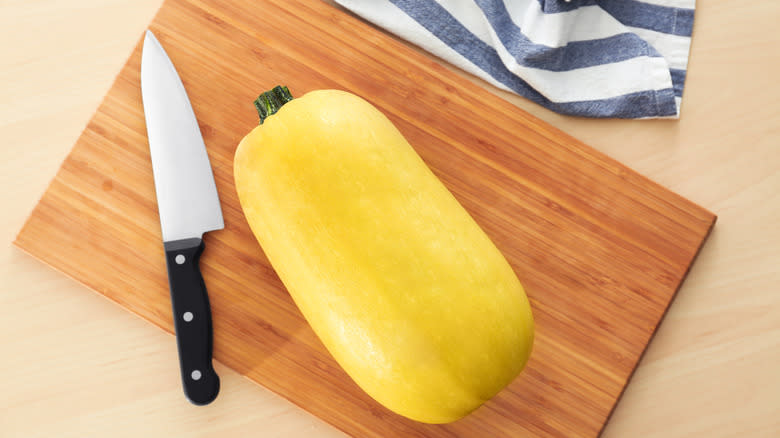
Spaghetti squash has a thick outer layer of skin that can be challenging to cut through, so it's essential to use a sharp knife. Some home cooks have the idea that a dull knife in the kitchen is safer, but the opposite is true. A dull knife can get stuck halfway through and then slip out expectedly, potentially leading to a dangerous cut or puncture, especially when cutting something like a winter squash. The best way to avoid injury is to use a large, sharp 10-inch chef knife and place the spaghetti squash on a dish towel for traction. A smooth kitchen countertop or cutting board is too slippery and increases the risk of injury.
One little trick to make tough spaghetti squash easier to cut is to pop the whole thing in the microwave for a few minutes to soften the skin. Just make sure to score the outside of the skin so the moisture can escape. After a few minutes, the skin will soften, and you can cut it in half, lengthwise, or in rings.
Skipping Washing The Outside Skin
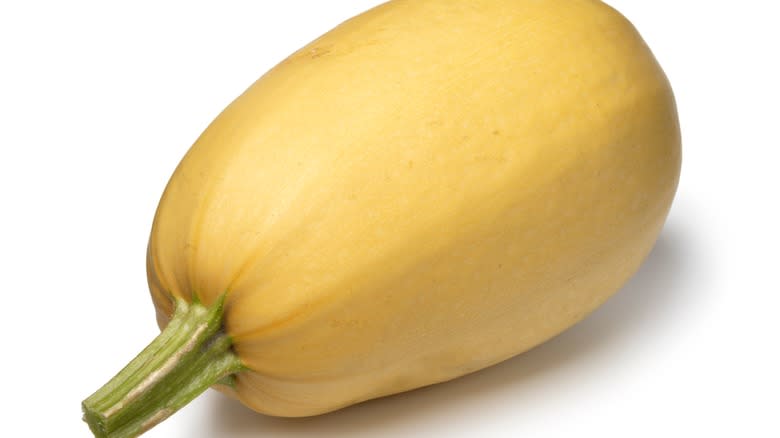
The outer skin of spaghetti squash protects the edible insides, so many home cooks don't think about washing the outside before cutting into it — but this is a mistake. From the time it's picked and transported, the squash has passed through many hands and is dirty with bacteria that will contaminate your knife when you cut into it. Washing the outside is the best way to keep you and your family safe from food-borne illness.
One reason some people skip this step is because they believe that any bacteria will be killed off in the cooking process. Unfortunately, germs are not the only things to be concerned about; pesticides can stick around on the outside of the squash, and cooking won't remove them completely. Even if you're using an organically grown spaghetti squash, it can still have this problem because some pesticides are still approved in organic produce, as Organic Authority explains. So do yourself a favor and avoid any dreaded nausea and tummy troubles by washing your spaghetti squash before cutting into it.
Trying To Roast It Whole
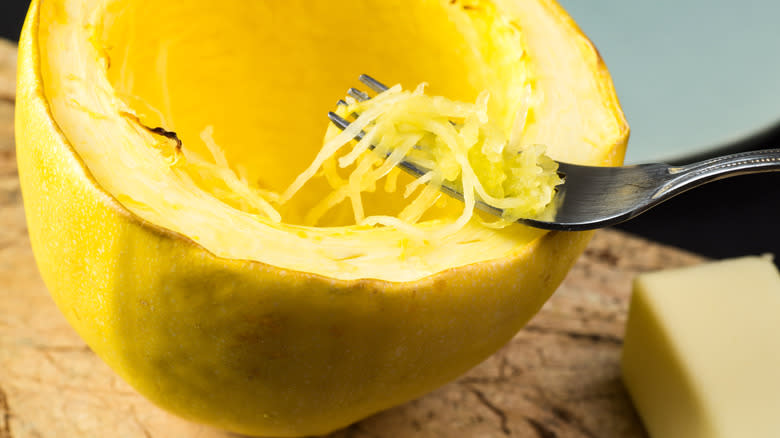
Many home chefs who are eager to try new cooking hacks will be disappointed if they try to roast the spaghetti squash whole. All over the internet, you can find this cooking hack and while you can technically roast the squash whole without cutting it, it isn't a good idea. The hack is praised as a time saver, but there are a few problems with this hack. The first is that it will take way too long to cook. Spaghetti squash generally takes between 30 and 45 minutes to roast when cut. Trying to roast it whole will only save prep time, but that time saved doesn't mean much when it causes the cooking time to increase. Plus, the seeds will be difficult to remove as they will be embedded into the soft flesh, and the outside skin will blacken and smoke up your kitchen.
Another reason why this matters is the taste. If you don't cut the squash, you miss out on the caramelization that happens when you roast it with olive oil. The heat also cooks the squash's natural sugars, and you get that slightly sweet flavor of caramelized spaghetti squash strands.
Tossing The Seeds In The Trash
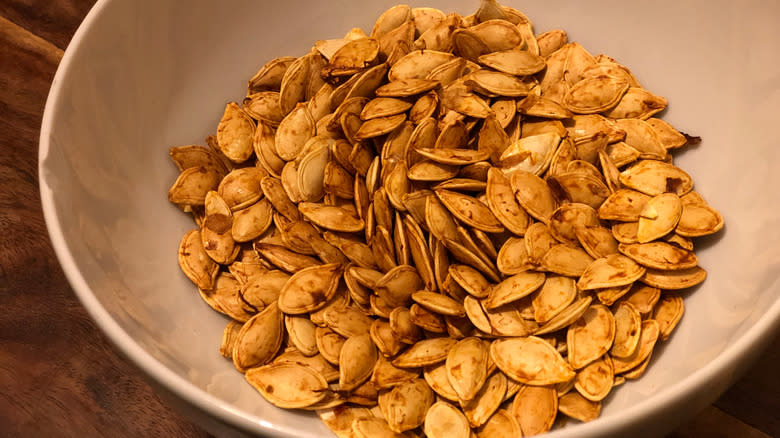
Pumpkin seeds aren't the only winter squash seeds you can roast — all winter squash seeds are edible. Once you cut your spaghetti squash, scoop out the flesh and seeds. The whole process of separating the seeds from the pulp is messy and time-consuming, but if you have an ice cream scoop, that can make it a little easier. Luckily, it's worth the effort. These little seeds make a healthy snack because they're packed with vitamins and minerals like vitamins A and C, plus they are a great source of fiber and plant-based protein.
Squash seeds are good with savory seasonings like smoked paprika and cumin but work well with sweet add-ins, too, like sugar and pumpkin spice. While roasting squash seeds is an easy process, it's a good idea to set a timer or just watch them closely because they can burn fast if you aren't paying attention.
Another excellent way to use spaghetti squash seeds is to make squash seed broth and use it in a creamy sauce. If you don't eat dairy you will be pleased to learn that pumpkin seeds are the base of many non-dairy sauces and cheeses. You don't need any special equipment — just a kitchen sieve and blender.
Roasting The Wrong Way Up
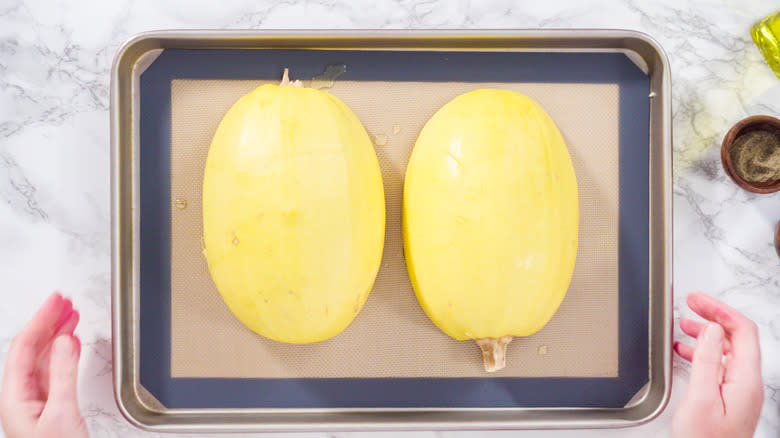
Roasting spaghetti squash is the most common way to cook it, but one common mistake is roasting the squash cut side up. The problem with roasting it like this is that each half is like a little boat that collects moisture. Water is released when the squash cooks and it just sits in the little boat, making the spaghetti squash strands too moist and mushy, instead of being like separate noodles. This is an easy fix — just roast your spaghetti squash cut side down. This lets the moisture out for firmer strands with the bonus of cooking more evenly.
Once the strands are removed, you can toss the skin in the compost bin. While some winter squash skins can be made into squash skin chips, spaghetti squash is not ideal for this because the skin is delicate when cooked, and baking it into chips makes it crack and crumble apart.
Starting Without A Plan
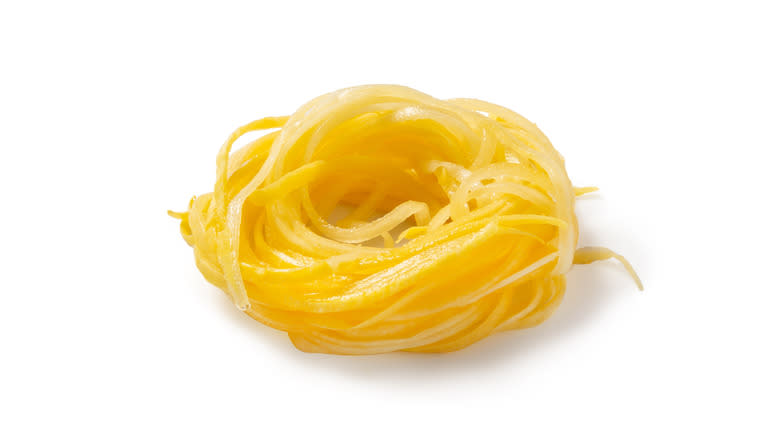
There are a lot of recipes out there for spaghetti squash, and you should go into preparing it with a plan in mind for how to use it. For example, if you want to use your spaghetti squash like pasta, you should cut and roast it in rounds so the long strands don't get split, resulting in longer noodles. If you want to make spaghetti squash boats, cut it lengthwise so each half creates a boat ready to be filled. Knowing how you plan on using this versatile squash is the best way to make the most of it.
Roasting isn't the only option for this yellow squash. You can also grill, steam, and even microwave it. Grilling rounds will add a nice smoky flavor, perfect as a side dish to steak, chicken, or fish. While steaming will keep the toothy bite without it getting too mushy, which is ideal if you want to use the noodles as pasta that can hold up to a heavy sauce like Alfredo. And if you want an even easier way to cook spaghetti squash, you can throw it in your slow cooker for a set-and-forget weeknight dinner. Just mix in some roasted veggies or use it as a bed for an eggplant or chicken parmesan.
Under Or Over-Cooking It
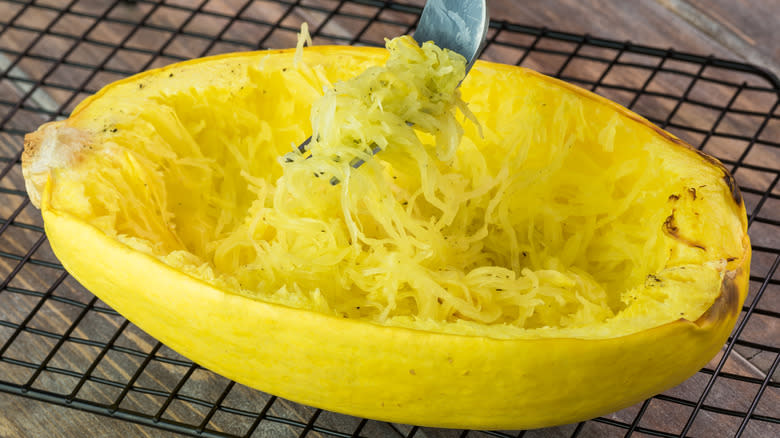
One of the most common cooking mistakes with spaghetti squash is overcooking it. It can be a challenging vegetable to cook, and it's easy to accidentally overcook it into a mushy mess, making the strands difficult to separate. The best way to keep it from overcooking is to set a timer for thirty minutes and then check it by raking a fork over the strands to see if they're coming apart. It should be easy to rake the strands, and they should feel tender but not overly soft.
Undercooking spaghetti squash is just as common as overcooking it. If it's undercooked, the texture will be too al dente, and the strands will stick to the flesh of the squash. One way to avoid undercooking is to score the outside skin so the heat evenly distributes throughout the squash. While some spaghetti squashes can roast for up to an hour, it depends on size, so keep this in mind and adjust the baking times accordingly.
Ideally, you should always cook squash before you eat it. Technically, you can eat summer squash raw, although it isn't the best way to enjoy it. Winter squashes, however, should never be eaten raw. They're too tough, and it will make for an unpleasant meal.
Forgetting To Oil And Add Seasonings
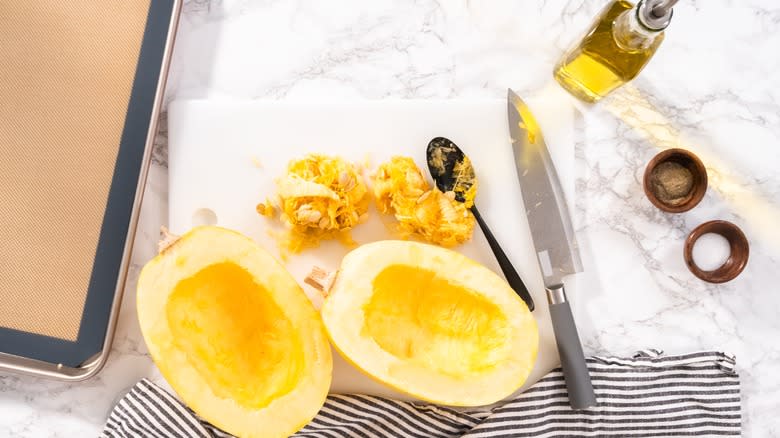
It's easy to forget to oil and season your cut spaghetti squash. Many home chefs get done with the cutting, and just throw it in the oven, but an important step that shouldn't be missed is drizzling olive oil on the inside and outside before it cooks. This helps the squash cook and sets the Maillard reaction in motion. The Maillard reaction is the chemical reaction of food cooked above 300 degrees Fahrenheit, causing the browning or caramelization that brings out the flavor. When the oil and heat connect, it takes the natural sugar in the squash and transforms it into caramelized perfection.
Every home cook knows to add salt and pepper, but with spaghetti squash, you'll want to take it a bit further to spruce up the neutral flavor. If you're using the stands as pasta, then it makes sense to sprinkle in Italian seasoning, but that isn't the only choice. You can take it south of the border with some cumin, oregano, and cilantro, add in some warming curry spices for an Indian take on spaghetti squash, or mix in some zesty za'atar for a tasty Middle Eastern twist.
Only Using It As Pasta
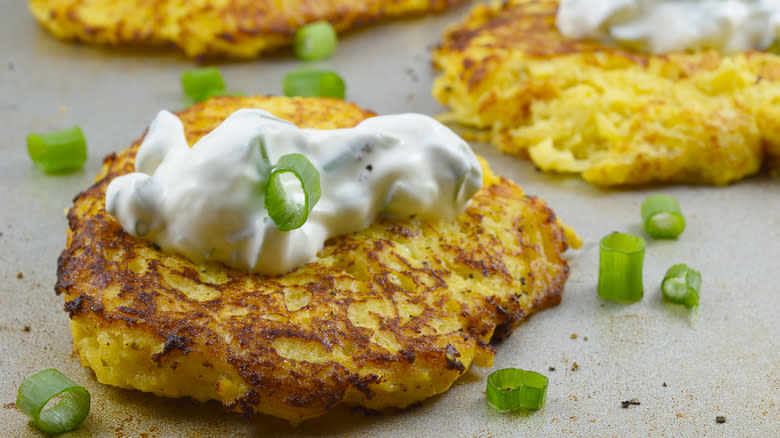
Don't make the mistake of only using spaghetti squash noodles for pasta dishes. There are a lot of excellent ways to use this delicious squash. Mix those strands with some egg and shredded potato for latkes or fritters. Make little spaghetti squash nests in a cupcake tin and crack in an egg for an impressive breakfast. Use the strands to make a low-carb pizza crust that rivals cauliflower crust. Or make a burrito bowl — just skip the rice and beans and use spaghetti squash instead. You can even give your favorite stir fry a makeover and replace the glass noodles with spaghetti squash strands. Adding this winter squash to your menu is a great way to eat healthy and exercise your creativity as you come up with new, fun ways to use it in your favorite recipes.
This versatile squash isn't just for savory foods. It makes a decadent dessert, too. Try making a spiced spaghetti squash cake with five-spice and Greek yogurt. The result is a spice cake with a texture that nicely balances a velvety cream cheese frosting. Or add it to a fruit crumble or crisp. The strands make a crunchy base on their own or mix with oats and nuts, then top with apples and walnuts cooked in cinnamon and sugar for a delicious dessert. The possibilities with spaghetti squash are truly endless.
Not Being Aware Of Toxic Squash Syndrome
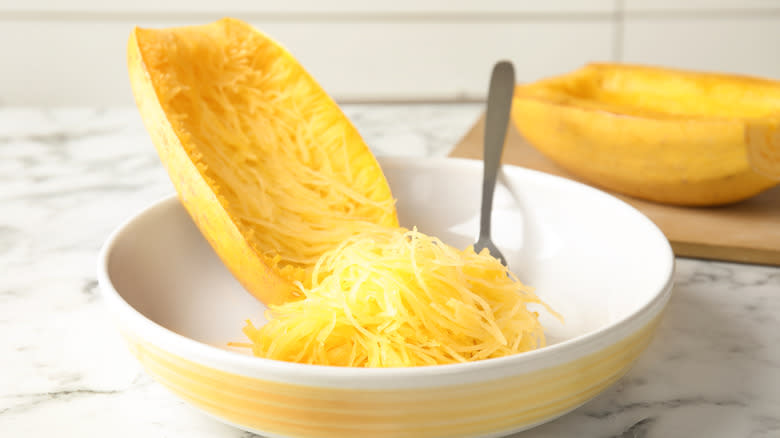
Squash has a dirty little secret that every home cook should be aware of: It can make you sick. There's an illness called toxic squash syndrome. It sounds like a made-up syndrome, but it is a type of foodborne illness that can be caused by winter and summer squash, and even one bite can cause pain and discomfort. Squash can contain a toxin called cucurbitacin E., and this toxin can cause cucurbit poisoning. It is impossible to know if the squash has the toxin only by looking at it; the only way diners can identify a bad squash is by its strong bitter taste. Bitter-tasting squash should always be thrown out.
According to Medicine Net, toxic squash syndrome is extremely rare, but there are some documented cases. Even so, don't let fear of toxic squash syndrome keep you from eating this healthy vegetable. Just be sure that you know what it is and, most importantly, be able to recognize it from the first bite.
Read the original article on Daily Meal.

